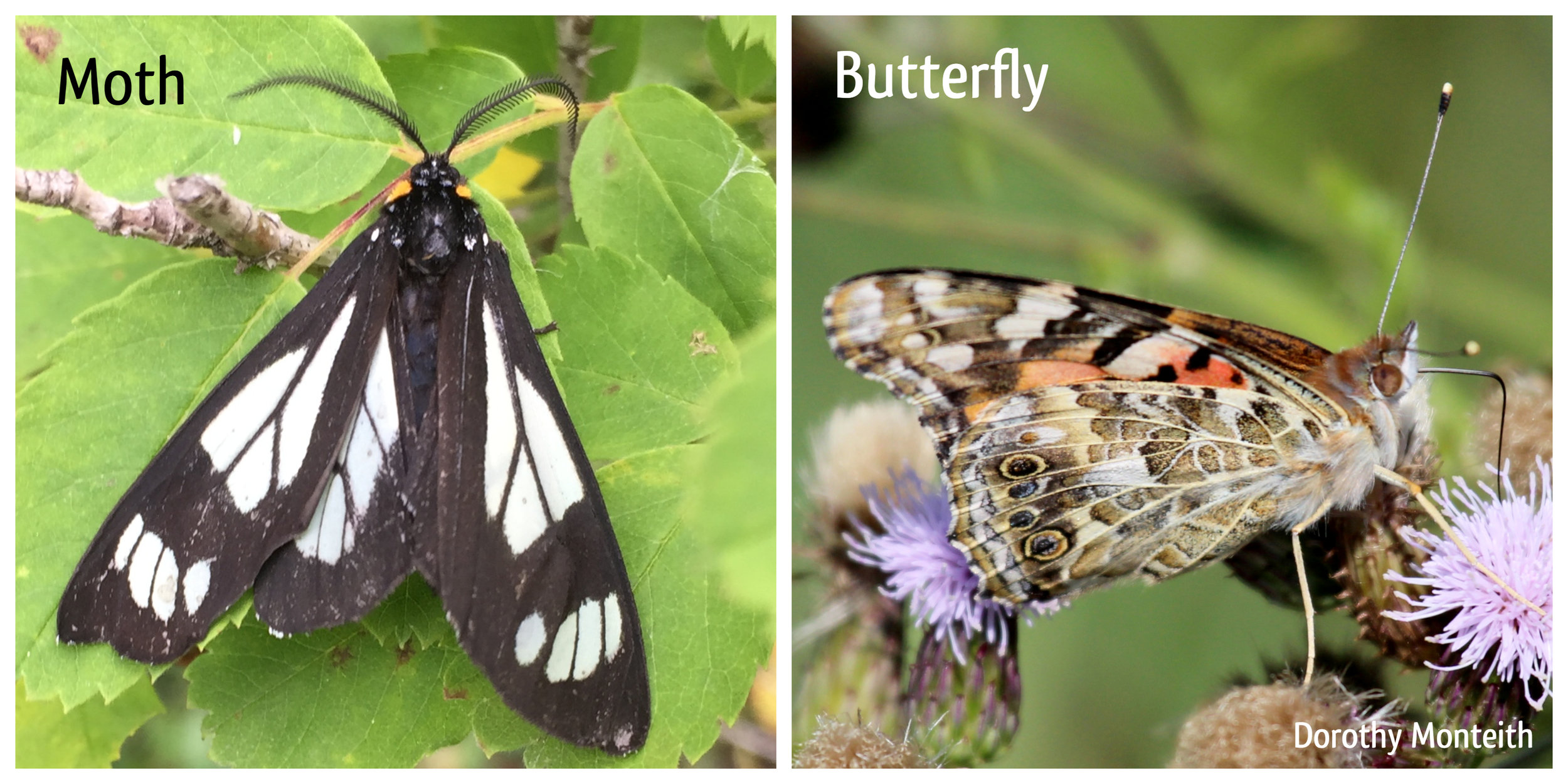Each year, countries all around the world recognize the last week of July as National Moth Week! To celebrate, we’ve written a blog all about moths for you to gain a greater appreciation for these amazing creatures. In Alberta, there are over 2000 species of moths, compared to only 150 species of butterflies! Learn more about how to tell the difference between moths and butterflies, some common species of moths in Alberta, and what you can do to help moths below.
Moth or Butterfly?
To the untrained eye, moths and butterflies look very similar. But since it’s National Moth Week, let’s learn about some of the main differences between moths and butterflies so that you can be an expert for your next outdoor excursion.
Butterflies
Clubbed antennae
Wings together & upright at rest
Mostly active during the day
Moths
Feathery antennae
Wings flat & to the side at rest
Mostly active at night
Some Alberta Moth Species
Now that you’ve learned what makes moths different from butterflies, you’re ready to go moth-ing! Grab your bug nets and magnifying glasses and head outside to try to find some of these awesome species of moths. We have a Moth Identification Guide online available for you to identify different species, or you can buy one to use in the field here! Here are some common Alberta moth species you might encounter:
Four-Spotted Ghost Moth
The four-spotted ghost moth is found across North America in poplar and mixedwoods forests. You’ll spot this moth in the summer months, namely July and August. It takes two years for larvae to complete their life cycle, and in Alberta specifically, this has resulted in four-spotted ghost moth adults being spotted more frequently in odd-numbered years - such as 2017, when this photo was taken! This moth got its name because of the way it attracts mates - males will hover over the ground, rising and falling slowly, like the motion of that of a ghost.
Hummingbird Clearwing Moth
The hummingbird clearwing moth can be found in forests, meadows, and residential gardens across Canada and the United States. As a caterpillar, this moth likes to eat honeysuckle, dogbane, and snowberry, but in its metamorphosed form, the hummingbird clearwing primarily burrows into poplar tree and shrub roots for food. As its name suggests, this species of moth has wings that beat very fast (similar to a hummingbird) that are also clear, giving it an interesting, distinct look.
LeConte’s Haploa Moth
The LeConte’s Haploa moth is commonly found in boreal forest regions across Canada and the United States. It wasn’t thought that its range extended as far west as Alberta, but they are now spotted here more regularly, with larvae being found in lakes east of Edmonton near the Ministik Conservation Lands. They are often spotted in July and have a very unique black and white Y-shaped pattern on their wings and a bright orange head.
Police Car Moth
The Police Car moth frequents North American forests and is usually seen in July and August. This beautiful black-and-white moth was named after the early police cars which were only black and white. Their unique colouration makes them easy to see, so this moth uses bad-tasting chemicals to protect it from being eaten. The police car moth also uses this defense because, unlike most moth species which are active at night, this moth is active during day. In its caterpillar form, it has a red head and black body with yellow markings, covered in stiff hairs.
Polyphemus Moth
The Polyphemus moth is one of the largest moths in Alberta, with wingspans up to 10-15 cm! They are found throughout Alberta in wooded areas - adults are found in June and caterpillars appear in July. This monster of a moth is rarely seen, though, as it is only active at night. However, like many other moths, the Polyphemus moth is attracted to light so sometimes you may see this moth turn up at your doorstep. That would be a big surprise - literally!
Sphinx Moth
The sphinx moth ranges all across Canada, most commonly along bodies of water or in areas with lots of willow and poplar, since this is an excellent source of food for them. They’re spotted between April and August, their wings span about the length of your pinky finger, and they are distinguishable by their brightly coloured hindwings and very robust thoraxes. Sphinx moths are also related to Hummingbird Clearwing moths because of similarities in flight patterns.
Virginia Ctenucha Moth
The Virginia Ctenucha moth lives across North America in open fields and meadows, commonly spotted from May to July. This species is characterized by its bright orange head, blue body, and greyish-black wings. In its caterpillar form, it is around 2.5 cm long, covered in tufts of yellow, white, and black hairs. Unlike most moths, the Virginia Ctenucha moth is diurnal, which means it is active and flying about during the day, so you’re more likely to see it than you are to see many other moths.
What can you do to help moths?
- Support land conservation through Edmonton and Area Land Trust. We work to protect important habitat for wildlife, including moths! You can contribute by making a donation or volunteering with us.
- Don’t swat them or kill moths if they get inside your house. Try to capture them using a bug net or a piece of paper and a glass and release them outside so that they can continue to live!
- Learn more about why moths are important! Sharing knowledge about moths and how they contribute to our ecosystems (such as pollinating flowers) will help to ensure that we protect these important species.








